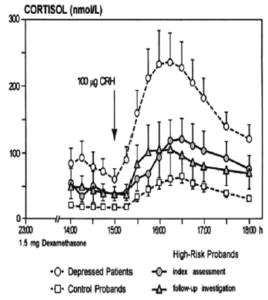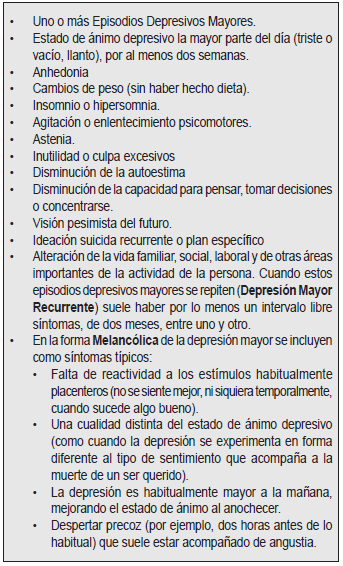La biología de la depresión se apoya en varias hipótesis, como la deficiencia de monoaminas (serotonina, norepinefrina y dopamina o 5HT, NE, DA), la hipótesis del estrés (CRH, cortisol, “lucha o huída”), acción de otras hormonas (catecolaminas,T3,T4, E2, progesterona, DHEA), citoquinas (conexión sistema inmunitario-cerebro), función opioide endógena alterada, disfunción de estructuras y circuitos cerebrales específicos, neurotransmisión glutamaérgica alterada, neurotransmisión GABAérgica reducida, ritmos circadianos anormales y un desequilibrio entre monoaminas y acetilcolina.
La deficiencia en la neuro-transmisión de mono-aminas, es la teoría más común en la génesis de la depresión (8). Un aumento de la actividad enzimática de la MAO-A disminuye la disponibilidad sináptica de 5HT y NE, al igual que su re-captación por medio de los transportadores.
En la neurona post-sináptica, las monoaminas se ligan a dos proteínas G de membrana, y por segundos mensajeros AMPc, IP3 y DAG, y proteínas quinasas C y A, generan CREB (elemento fijador de la respuesta al AMPc) en el núcleo, el que a su vez produce neuropéptidos como la neurotrofina o “Factor neurotrófico derivado del cerebro “. Este proceso está reducido en depresión.
La hipótesis de la depresión mayor causada por CQ se basa en que los glucocorticoides y las catecolaminas –principales hormonas del estrés- suprimen de forma sistémica (Fig. 2) la inmunidad mediada por células T que liberan CQ pro-inflamatorias Th1 (IL1, TNF-alfa, INF-gamma); dirigen entonces la producción de CQ hacia las anti-inflamatorias Th2 (IL10, IL4 y TGF-beta).
Las CQ de cada uno de estos grupos tienden a inhibir la acción de las del otro grupo, y su mala regulación (o desbalance) tiene un posible papel en la patogénesis de las enfermedades autoinmunes. La exposición a CQ induce síntomas depresivos (en animales, la “conducta enferma” y en humanos, el uso de tratamientos de cáncer o hepatitis C); los antidepresivos tienen efectos anti-inflamatorios; las CQ afectan las mono aminas (reducen 5HT por reducir la disponibilidad del precursor triptófano) y causan hiperactividad del eje HPA.


Figura 4. La mitad de los pacientes deprimidos presenta falta de supresión post-dexametasona de ACTH y cortisol
y una hiperrespuesta de los mismos al administrar CRH. Las pruebas dinámicas neuroendocrinas se utilizan a
veces para aclarar el diagnóstico diferencial .Modificado de Schüle C, Baghai TC et al(41) .
En DM entonces se pierde el balance entre citoquinas producidas por Th1/Th2, entre el catabolismo y el anabolismo, representado por las hormonas Cortisol/ DHEA. Una prueba denominada “Stress check” mide estrés en saliva por desbalance hormonal (cortisol libre, DHEA, testosterona, cotinina), Se han vuelto populares productos de venta libre como DHEA, melatonina, estimulantes de hormona del crecimiento, vitaminas antioxidantes, que supuestamente producen bienestar y aumentan la longevidad.
El cuadro clínico de la depresión mayor se puede observar en la Tabla 6 (42).
Tabla 6. Diagnóstico de Depresión Mayor

Podemos finalizar diciendo que el estrés –tanto agudo como crónico- se constituye en el mal del siglo XXI. Traumas, como los psicosociales de la infancia, llevan al estrés del adulto. Este favorece la aparición de trastornos psiquiátricos como la depresión, por mecanismos neuroinmunohormonales; por estas complejas relaciones, se desarrollan luego enfermedades como el síndrome metabólico, infecciones, enfermedades autoinmunes y trastornos demenciales (43-50).
Debido a esto están en boga –además del ejercicio regular moderado- las técnicas de relajación, diversas psicoterapias, una dieta saludable y una vida alejada de las toxicomanías. Los gobiernos tienen ante sí importantes retos para corregir o disminuir las inequidades sociales (fuentes primordiales de estrés) y el mejoramiento del entorno familiar, núcleo de donde podría generarse un futuro más esperanzador. Y tal como lo hemos visto en esta breve revisión, en años venideros se encontrarán en el mercado medicamentos modernos que intervendrían en la corrección de diversos mecanismos fisiopatológicos generadores de la sobrecarga alostática.
Referencias
1. Selye H. Syndrome produced by diverse nocious agents. Nature 1936; 138:32.
2. Prolo P, Chiappelli F, Fiorucci A, Dovio A, Sartori ML, Angeli A. Psychoneuroimmunology: new avenues of research for the twenty-first century. Ann N Y Acad Sci. 2002; 966: 400-408
3. Flores M, Ontiveros MP. Hormonas gonadales y depresión en la perimenopausia. Rev Col Psiquiat 2008; 37(2): 236-246
4. Young EA, Midgley AR, Carlson NE, Brown MB. Alteration in the hypothalamic-pituitary-ovarian axis in depressed women. Arch Gen Psychiatry 2000;57: 1157-62
5. Salvador J. Neuroendocrinología del estrés. 8º Congreso Colombiano de Endocrinología, “De la biología molecular a la práctica clínica”, 2005. Bogotá
6. Tsuru J, Akiyoshi J et al. Social support and enhanced suppression of adrenocorticotropic hormone and cortisol responses to hypothalamic-pituitary-adrenal function and thyrotropin-releasing hormone tests in patients with major depressive disorder. Biol Psychol. 2008; 78(2): 159-63
7. Trucco M. Estrés y trastornos mentales, aspectos neurobiológicos y psicosociales. Rev Chil Neuropsiquiatr 2002; 40 (S2): 8-19
8. McEwen BS. Stressed or stressed out: what is the difference? J Psychiatry Neurosci 2005; 30: 315-318
9. Belmaker RH, Agam G. Major Depressive Disorder. N Engl J Med 2008; 358:55-68
10. Swaab DF,Bao AM, Lucassen PJ. The stress system in the human brain in depression and neurodegeneration. Ageing Res Rev 2005; 4: 141-194
11. Tanaka M, Telegdy G. Antidepressant-like effects of the CRF family peptides, urocortin 1, urocortin 2 and urocortin 3 in a modified forced swimming test in mice. Brain Res Bull. 2008; 75(5):509-512
12. Chen C. Recent advances in small molecule antagonists of the corticotropin-releasing factor type-1 receptor-focus on pharmacology and pharmacokinetics. Curr Med Chem. 2006; 13: 1261-82
13. Weniger SC et al. Stress-induced behaviours require the corticotrophin-releasing-hormone (CRH) receptor but not CRH. Proc Natl Acad Sci 1999.
14. Cao J et al. Human mast cells express corticotrophinreleasing hormone (CRH) receptors and CRH leads to selective secretion of vascular endothelial growth factor. J Immunol 2005; 174. 7665-7675
15. Speert DB, Seasholtz AF. Corticotrophin-releasing hormone receptors and ligands in stress: who’s on first? Curr Op Endocrinol & Diab 2001; 8: 161-165
16. Van Houdenhove B, Van Den Eede F, Luyten P Does hypothalamic-pituitary-adrenal axis hypofunction in chronic fatigue syndrome reflect a ‘crash’ in the stress system?.Med Hypotheses. 2009 Jun;72(6):701-5.
17. Mesquita AR, Wegerich Y, Patchev AV, Oliveira M, Leão P, Sousa N, Almeida OF. Glucocorticoids and neuro- and behavioural development.. Semin Fetal Neonatal Med. 2009 Jun;14(3):130
18. Ball TM. Cortisol circadian rhythms and stress responses in infants at risk of allergic disease. Neuroimmunomodulation. 2006;13(5-6):294-300.
19. Taché Y, Bonaz B. Cortisol circadian rhythms and stress responses in infants at risk of allergic disease J Clin Invest. 2007 Jan;117(1):33-40.
20. Monteleone P, Martiadis V, Maj M.Circadian rhythms and treatment implications in depression. M. Prog Neuropsychopharmacol Biol Psychiatry. 2010 Aug 5.
21. Westrich L, Sprouse J. Circadian rhythm dysregulation in bipolar disorder. Curr Opin Investig Drugs. 2010 Jul;11(7):779-87. Review.
22. Boyce P, Barriball E. Circadian rhythms and depression. Aust Fam Physician. 2010 May;39(5):307-10. Review.
23. Virk G, Reeves G, Rosenthal NE, Sher L, Postolache TT. Short exposure to light treatment improves depression scores in patients with seasonal affective disorder: A brief report. Int J Disabil Hum Dev. 2009 Jul;8(3):283-286.
24. Calcagni E, Elenkov I. Stress system activity, innate and T helper cytokines, and susceptibility to immune-related diseases. Ann N Y Acad Sci. 2006;1069: 62-76
25. Elenkov IJ, Lezzoni DG, Daly A, Harris AG, Chrousos GP. Cytokine dysregulation, inflammation and wellbeing. Neuroimmunomodulation. 2005; 12: 255-69
26. Schiepers OJ et al. Cytoquines and major depression. Prog Neuropsychopharmacol Biol Psychiatry 2005; 29: 201-217
27. Bazzichi L, Rossi A et al. Association between thyroid autoimmunity and fibromyalgic disease severity. Clin Rheumatol. 2007; 26: 2115-2120
28. Davis JD, Tremont G. Neuropsychiatric aspects of hypothyroidism and treatment reversibility. Minerva Endocrinol. 2007; 32: 49-65
29. Carta MG, Loviselli A, Hardoy MC et al. The link between thyroid autoimmunity (antithyroid peroxidase autoantibodies) with anxiety and mood disorders in the community: a field of interest for public health in the future. BMC Psychiatry. 2004; 4: 25
30. Oomen HA, Schipperijn AJ, Drexhage HA. The prevalence of affective disorder and in particular of a rapid cycling of bipolar disorder in patients with abnormal thyroid function tests. Clin Endocrinol (Oxf). 1996; 45: 215-23
31. Bokhari R, Bhatara VS, Bandettini F, McMillin JM. Postpartum psychosis and postpartum thyroiditis. Psychoneuroendocrinology. 1998; 23: 643-50
32. Gill JM, Szanton SL, Page GG Biological underpinnings of health alterations in women with PTSD: a sex disparity .Biol Res Nurs. 2005; 7:44-54.
33. Nemeroff CB, Simon JS, Haggerty JJ Jr, Evans DL. Antithyroid antibodies in depressed patients. Am J Psychiatry. 1985; 142: 840-3
34. Carta MG, Hardoy MC et al. Association between panic disorder, major depressive disorder and celiac disease: a possible role of thyroid autoimmunity. J Psychosom Res. 2002; 53: 789-93
35. Guimarães JM, de Souza Lopes C, Baima J, Sichieri R. Depression symptoms and hypothyroidism in a population-based study of middle-aged Brazilian women. Affect Disord. 2009 Jan 23
36. Fountoulakis KN et al. Thyroid function in clinical subtypes of major depression, an exploratory study. BMC Psychiatry 2004; www.biomedcentral. com/1471-244X/4/6
37. Lizcano F, Rodríguez JS. Efectos del tratamiento del hipertiroidismo e hipotiroidismo sobre la actividad del sistema del estrés. Acta Med Colomb 2007; 32: 39-46
38. Ackerman LS. Sex hormones and the genesis of autoimmunity. Arch Dermatol 2006; 142: 371-376
39. Lindqvist D, Isaksson A, Träskman-Bendz L, Brundin L. Salivary cortisol and suicidal behavior—a follow-up study. Psychoneuroendocrinology. 2008; 33 (8): 1061-80
40. Swaab DF, Bao AM, Lucassen PJ. The stress system in the human brain in depression and neurodegeneration. Ageing Res Rev. 2005; 4:141-94.
41. Land BB, Bruchas MR et al. The dysphoric component of stress is encoded by activation of the dynorphin kappa-opioid system . J Neurosci. 2008; 28(2):407-414
42. Schüle C, Baghai TC et al. The combined dexamethasone/ CRH Test (DEX/CRH test) and prediction of acute treatment response in major depression. PLoS ONE. 2009; 4: e4324.
43. Rosembaum JF. Antidepressant treatment and the biology of depression. 2001. www.medscape.com
44. Di Marco F, Santus P, Centanni S. Anxiety and depression in asthma..Curr Opin Pulm Med. 2010 Oct.
45. McEwen BS, Gianaros PJ.. Frontiers in the use of biomarkers of health in research on stress and aging. Ann N Y Acad Sci. 2010 Feb;1186:190-222
46. Nautiyal KM, Ribeiro AC, Pfaff DW, Silver R. Brain mast cells link the immune system to anxietylike behavio Proc Natl Acad Sci U S A. 2008 Nov 18;105(46):18053-7. Epub 2008 Nov 11.
47. Cerqueira JJ, Almeida OF, Sousa N. The stressed prefrontal cortex. Left? Right! Brain Behav Immun. 2008 Jul;22(5):630-8.
48. Reiche EM, Nunes SO, Morimoto HK Stress, depression, the immune system, and cancer.Lancet Oncol. 2004 Oct;5(10):617-25. Review.
49. Spiegel D, Sephton SE. Psychoneuroimmune and endocrine pathways in cancer: effects of stress and support. Semin Clin Neuropsychiatry. 2001 Oct;6(4):252-65.
50. McEwen BS, Gianaros PJ. Central role of the brain in stress and adaptation: links to socioeconomic status, health, and disease. Ann N Y Acad Sci. 2010 Feb;1186:190-222ACIONAL DE MEDICINA, SALUD
